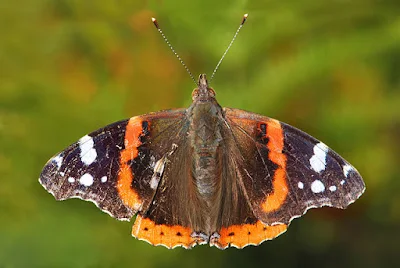30+ Interesting Facts About Butterflies
- There are around 18,500 species of butterflies on earth. They are present on every continent except Antarctica.
- An important reason for the wide-scale distribution of butterflies on earth is their migration from one part of the earth to another. Painted lady and monarch butterflies are good examples that can migrate over long distances.
- The discovery of butterfly fossils indicate that this insect has been on earth since 56 million years ago.
- Butterflies are beneficial for plants as they assist in the pollination of those plants that they visit. Butterflies can carry a smaller amount of pollen than bees, but they can take the pollen to longer distances.
- Butterflies also provide other benefits to plants. Harvester (a carnivorous butterfly) and a few other butterfly species eat harmful insects.
- Several birds, insects, amphibians, and other animals eat butterflies. Common predators of these insects are wasps, dragonflies, sparrows, parrots, frogs, lizards, etc.
- Butterflies use several defensive techniques to protect themselves from these predators. These include camouflage, toxins, auditory defenses, head fake, unpredictable flight, etc.
- Few species of butterflies (e.g. cabbage white butterfly) act as pests. These butterflies damage crops or trees during their larval stage.
- The primary source of nutrition for butterflies is nectar and pollen from flowers. However, they also get food and additional nutrition through tree sap, rotting fruit, decaying flesh, dung, dissolved minerals in wet sand, and human sweat (for sodium).
- Adult butterflies can only consume liquids. They use their proboscis (elongated mouthpart) to suck their food.
- The largest species of butterfly is Queen Alexandra’s birdwing. The wingspan of females in this butterfly can reach 30 cm. It is present exclusively in northern Papua New Guinea and is one of the few endangered species of butterflies. (Source)
- The western blue pygmy is the smallest known butterfly in the world. It has a wingspan of just 0.5 in (1.3 cm).
- Skippers are the fastest butterflies that can fly at a speed of 37 mph. Nearly 4,000 species of this butterfly are present everywhere on earth except Antarctica.
- Butterflies use their antennae for several purposes. These antennae are functional as smell receptors, light receptors, navigators, and for keeping balance. (Source)
- Butterflies are one of the few animals that can see UV light. They use this ability to locate flowers with nectar. Butterflies can also emit UV light through their wings. It assists them in defense against predators and can also operate as a secretive way of courtship.
- This
ability of the butterfly’s wing to absorb and re-emit UV light has played a significant
role in developing high-emission LEDs (light-emitting diodes). It is a more
efficient LED compared to standard LEDs. Butterflies have been using the same
method for the past 30 million years. (Source)

Wings of butterfly assisted in development of modern technology - Butterfly wings are also behind the progress of other modern technologies, including nanotechnology. Scientists have developed an extremely smaller device to make optical communication faster and more secure. This device is the result of imitating structure in butterfly wings. (Source)
- The common bluebottle butterfly has at least 15 different types of photoreceptors in its eyes for color vision. Most insects have three classes of photoreceptors, while many butterfly species contain four receptor classes. (Source)
- Butterflies can spot various colors, but are nearsighted and cannot see detailed patterns. However, they have a wide view angle. A butterfly species, Empress Leilia, has a visual field of 344 degrees compared to 190 degrees in humans.
- There are 845 butterfly species in the USA and Canada. The genomes of all these species have been sequenced. (Source)
- Glasswing butterflies and some other species have transparent wings. This transparency is the result of the antireflective properties of their wing membranes. (Source)
- Like moths and flies, butterflies taste the food through their feet. These insects can sense sweet, bitter, salty, and sour flavors through their taste buds.
- There are several differences between butterflies and moths. One can easily differentiate between them through the dissimilar shapes of their antennas and the position of their wings at rest. Butterflies have more colorful wings compared to moths’. Butterflies and moths are primarily diurnal and nocturnal, respectively. (Source)
- In many butterfly species, the flight is only possible if their muscle temperature is between 30 and 38 C. (Source)
- Butterflies have four separate colorful wings. These are the only insects having wings with tiny scales.
- The name "butterfly" is either due to the color of their excrement or because they were considered to steal butter.
- Female butterflies choose the most appropriate leaves to lay eggs through their smell and taste. They also attach their eggs to leaves by using a glue-like substance.
- During the caterpillar stage, butterflies are usually carnivorous and eat aphids and other small insects.
- The larvae of lycaenid butterflies provide sugars and amino acids to ants through nectar. In turn, ants protect the butterfly from enemies. (Source)
- The smell of the outer coat of the Alcon blue butterfly’s caterpillar is similar to the smell of ants. The ants take the caterpillar in their colony to take care of by considering it one of their kinds. (Source)
- Several butterfly species have tails that resemble the antennae. This false head assists the butterfly in escaping from predators. (Source)
- Few butterfly species use their snake-like appearance during the caterpillar stage as a defensive technique. These include swallowtail butterflies, orange-tip butterflies, and silver-spotted skipper butterflies. (Source)
- The average lifespan for various butterfly species is from two to four weeks. Few species can live for up to a year. (Source)



Comments
Post a Comment